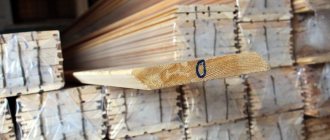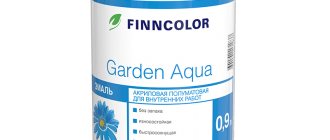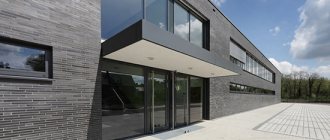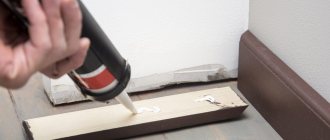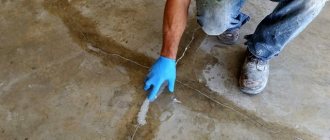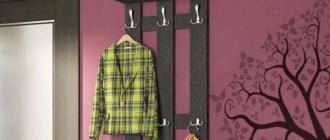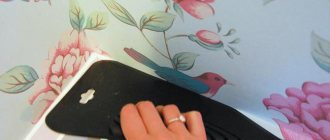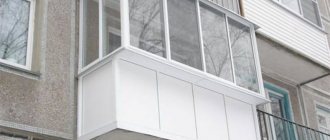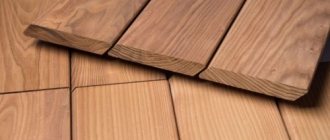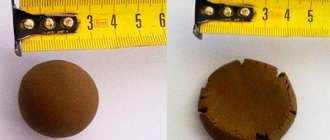Good day everyone, and good mood! I hope winter will go away soon and we can enjoy spring. Spring is also a period of active construction. It’s not for nothing that we are talking about installing plank on the facade.
Popular finishing material. Available in several varieties. It also differs in the method of attachment to the surface.
I’m not sure that taking video training will be enough to cover a house with your own hands without any experience. The technology is not simple.
But at least you need to monitor the work of the builders. And understand whether they are doing the right thing or not. If you practice, you can do everything yourself.
What is planken and its varieties
The unusual name hides an ordinary board made from different types of wood. It’s just processed on all sides and has a standard thickness: from 20 to 24 mm. The length starts from 2 m, it all depends on the technical and technological capabilities of the equipment used.
Planken is available in three varieties on the market:
- Direct . This is a board whose cross-section is a rectangle with right angles (90°). This type of plank is not used for cladding houses. When joining the boards, gaps form between the boards, through which the sheathing is visible. Moisture also penetrates here, which negatively affects the finish, as well as dust and debris. Typically, this type of finishing material is used in the production of sandbanks or the construction of fence structures.
Direct version of planken Source diesel.elcat.kg
- Beveled . During processing, the ends of the material are cut at an angle of 45°. That is, the cross-section results in a parallelogram. During installation, the adjacent beveled planes of the two sheathing elements being connected are joined, and one part covers the other. An almost seamless cladding is obtained on the surface of the wall being finished. Therefore, this type of plank can be used for façade cladding of house walls.
Beveled variety of planken Source sekil.yukle.mobi
- Wedge-shaped , that is, the thickness of the material varies along the width of the board. Cladding a house with this type of plank has an original look. And this is where its advantages over other types end.
Wedge-shaped planken Source houtweb.nl
Now about why this finishing material is more expensive than lining, although it is no different from it. As mentioned above, manufacturers, by changing the name, receive fabulous profits. For example, the price of “Extra” class Euro lining is 850-900 rubles. for 1 m². The price of planken of the same class is 1300 rubles/m². The difference is 40%.
But that's not all. It is necessary to talk about the cost of planken and the technology of its production. Let's start with the fact that this building material is made on a conventional four-sided jointer. Cutting is done with straight cutters, which are easier to install and adjust, and easier to sharpen. In the production of lining, milling cutters with complex profiles are used. That is, the cost of planken is lower than that of lining. That is, manufacturers deceive consumers twice.
Four-sided jointing (planing) machine Source remlandia.ru
Scope of application of planken
As mentioned above, direct modification is used in the production of furniture, decorative elements and fencing structures. Beveled and wedge-shaped are mainly used for finishing facades, as well as in the interior design of premises. When the task is external cladding, the plank is treated with protective impregnations, varnishes and paints. The latter are rarely used, because the pattern of the wood structure is hidden under the paint layer. But paints are often used in interior decoration.
It should be noted that any structure can be sheathed with planken. That is, it can be a stone house, a wooden log house or a frame building. This universal material, like lining, is mounted only on the sheathing, which is installed and attached to the walls of the house.
Straight plank fence Source electric-fences.net
See also: Catalog of companies that specialize in facade and finishing materials.
Beautiful and practical material for finishing facades
In essence, planken is a facade board , for the processing of which modern technologies and equipment are used, which ensures the high quality of this material.
In many of its properties, it is close to such finishing products as lining or block house, but it is a fundamentally different product of the woodworking industry, differing from its “relatives” both in appearance and installation method.
In terms of strength characteristics, planken is very close to deck or terrace boards, it is highly resistant to negative natural factors, thanks to which it can be used not only for exterior decoration, but also, for example, for the construction of fences, gazebos and other structures on a country site.
Several types of wood are used to produce planken, but the most popular are products from Siberian larch and pine, although on the market you can also find material for the manufacture of which exotic species were used.
Deciduous wood, such as ash, is used less frequently, but only after special heat treatment, which provides the necessary strength. The most widely used material is made from larch, but pine plank finds its application, most often it is used for interior decoration.
In order to improve its performance characteristics, the wood is subjected to special heat treatment: planken obtained from thermowood acquires additional strength and becomes less vulnerable to the effects of natural moisture and microorganisms.
And, despite the fact that coniferous wood, due to the presence of resins, has a certain resistance to moisture, as an additional protection for the material, a special composition is applied, which also has decorative and aesthetic functions, as it allows you to emphasize the beauty of the wood pattern.
But, if the implementation of an architectural or design concept requires a material of a certain color, then you can buy painted plank.
A separate type (or “competitor”) of planken can be considered wood-polymer composite (WPC), for the production of which wood shavings and polymers are used. It is characterized by increased moisture and wear resistance and has dimensions similar to traditional planken.
Technology of cladding house walls with planken
The finishing of the facade with planken is usually carried out horizontally. This means that the sheathing elements are installed vertically in the same plane. But you need to start by calculating the amount of planken required for cladding. Everything is simple here - the area of the wall is divided by the area of one board, and 5-10% is added to the resulting number (as reserve for trimming).
Installation of the frame (lathing)
For lathing, you can use wooden bars with a cross-section of 50x50 mm or galvanized metal profiles, which are used when installing plasterboard sheets. The second option is better because with changes in humidity and temperature, which are common outside, they do not change their size and characteristics.
Depending on which house is planned to be finished with planken, minor repairs to the walls are carried out. This mainly applies to brick, block and stone buildings. Repair is the repair of wall defects and priming of its surface so that the surface layer does not crumble.
Frame made of wooden bars under planken Source fd-kostroma.ru
- Then vertical lines are drawn from the corner of the building along its entire length every 50-60 cm .
- Direct hangers along the lines every half meter , which are attached to the wall of the house with self-tapping screws. wooden blocks are used as sheathing elements , then fastening can be done with long self-tapping screws , screwing the slats directly to the wall. Wooden stands are installed in the pestles to lower the plane level.
- Metal profiles or slats are attached strictly vertically to the suspensions . The main task of the work manufacturer is to form one vertical plane .
If wooden slats were used as lathing, they must be treated with an antiseptic composition.
Practical advice
To get high-quality and beautiful larch plank cladding, you need to take into account the following recommendations from professionals:
- Reducing the pitch of the sheathing, or rather its vertical slats, will help eliminate the deformation of the boards or make it less noticeable.
- Correctly chosen fastening is the key to an attractive finish, so it is worth choosing the right fastening elements.
- Ensuring proper ventilation will prevent damage to the material and will allow you to maintain a comfortable atmosphere inside rooms decorated with larch boards.
An ideal solution for a country home
By choosing high-quality materials, following simple installation technology and taking into account expert advice, you can create a beautiful and reliable cladding that will last for a long time.
Planken made of larch is an excellent choice for cladding a house, since the strength and visual appeal of the material make it possible to obtain a finish that will cope with the functions assigned to it to the maximum.
Ease of installation and ease of maintenance have made such wooden boards very popular not only among beginners, but also among professionals.
Video description
To make it clearer to you how the plank is installed on the facade of the house, we suggest watching a video:
There is another option for attaching the plank. It uses decorative nails. They are simply driven into the boards at the location of the sheathing elements. The opinions of designers in this regard differed greatly. Some say that the heads of even decorative nails spoil the appearance of a building. Others, on the contrary, welcome the unusual approach to implementing such a design solution. The choice, as always, remains with the owner of the house.
Wall cladding with planken fastening with decorative nails Source lt.decoratex.biz
The third fastening option is overlap. This is done like this: the first row is installed at the very bottom without a starting bar. Fastenings are carried out with long nails or self-tapping screws, which are driven into the upper part of the plank. The second row is laid so that the lower edge of the boards covers the upper part of the plank of the first row. In this case, the upper elements of the cladding will cover the caps of the fasteners. Everything is exactly the same with other rows. That is, it turns out that each board is attached only along the top edge. This is clearly visible in the photo below.
Laying planks overlapping each other Source remlandia.ru
Fastening systems
Many people are puzzled by the question of how to attach the plank. There are two main types:
- using self-tapping screws. Installation is simple, no special fastening systems are required, facade cladding takes less time than with hidden cladding. The disadvantage of this method is the visibility of the screws.
- using hidden fastening systems - a more complex and time-consuming installation method. The main advantage is the beautiful, aesthetic appearance of the house, with invisible fasteners. In this case, finishing will take longer and will cost more if the installation is carried out by hired builders.
The specific method of fixing the plank depends on a number of factors, the main of which are the type of boards, budget and requirements for the aesthetic appearance of the cladding.
Repair of a plank wall
Planken, like lining, does not cause any particular trouble. But sometimes situations arise when you need to replace one board. This process is actually very complex. You can't do it yourself. Even many experienced craftsmen encounter problems when carrying out repair work if Duet clamps were used for fastening.
Here is the sequence of operations:
- It is necessary to tap the board being replaced to determine the location of the frame elements. Mark these places with a pencil .
- If in the future the defective cladding part is not used somewhere, then it can be cut with a grinder , on which a thin cutting disc is used, used for cutting metal. The main task in this situation is not to damage the sheathing .
- After that, the cut parts of the board , and then the fasteners are dismantled
If the planken board is used somewhere in the future, then dismantling it will be much more difficult. To do this you need to get to the fasteners. Usually, to do this, use a chisel to select the location of the intended fasteners, which are then dismantled, that is, the screws are unscrewed.
But the most interesting thing is that the open space must be covered with plank, which will have to be fastened to the frame elements with nails. In this case, the caps cannot be left if other fastening methods were used during the sheathing process. After that, the fastening points are covered with colored putty, matched to the color of the plank, or tinted.
Cladding installation methods
Some types of fastenings are suitable for regular larch planks, others for boards with grooves. In any case, the use of such parts will help speed up the process of covering the facade of the house.
Snake
Used for beveled larch planks. The fastener is fixed on each board and, when joined, forms a wave. The snake should protrude beyond the edges of the plank so that there is room for fastening it to the sheathing with a self-tapping screw. Each element also has a flange that helps form a ventilation gap.
Planfix
When using such fasteners, you will need to additionally secure the top and bottom boards with nails. Fixation is carried out on the side of the sheathing. Planfix is a metal plate bent at a right angle. There is also a spike on the fastener, which helps securely secure the finish.
Bridge
A universal element that can be used for any type of material. The metal plate has two antennae, due to which fixation occurs. There is a hole in the middle of the plate, which is intended for attaching the part to the sheathing.
Crab
Fasteners are used for larch planks with grooves. These are two plates, one has a hole for fixing to the sheathing, as well as antennae where the boards are inserted. This mounting option is one of the most durable and practical. The crab can be easily moved to the side in order to repair a separate part of the cladding.
Key
Facade plaster mesh
Fasteners for planken “key”
One of the simplest options for fastening planks, which does not require special skills or tools. Designed for creating decking from boards and is available in several versions for different types and profiles of boards (the exception is planks with grooves, for which you should choose a different type of fastening). It looks like a regular key and has a hole for a self-tapping screw in the head.
A variation of the “key” are the British-made Gvozdek and Richard Babidge fasteners, but the latter has one significant difference - the absence of a special stopper, which provides the necessary technical clearance. Accordingly, when working with it it is necessary to use plastic crosses or other devices.
Advantages of the “key” fastener:
- attaches two boards to the frame structure at once, making installation much faster;
- on the main part of the element there are special notches that ensure reliable fixation and prevent the fasteners from slipping out of the boards, which can be caused by weather conditions;
- has no sharp edges, so walking on flooring installed in this way is absolutely safe;
- allows for uniform spacing of boards.
Step-by-step instructions for installing “key” fasteners
Step 1. Make appropriate markings on the sheathing.
Step 2. Install “keys” in all places where the sheathing elements intersect with the plank.
Step 3. Hammer the fastener into the joist at an angle of 45 degrees so that it enters the wood up to the head.
Hammering fasteners into the sheathing
Drive the fasteners all the way to the head
Clogged fasteners and board
Step 4. Install the first board and bend the cap close to its surface (the tenon, which is located on the back of the cap, should be perpendicular to the side surface).
Bend the cap with a hammer
The head of the fastener should be positioned close to the board
Step 5. Screw the self-tapping screw into the hole on the head, thus securing the board.
Tighten the self-tapping screw
Step 6. Place the next cladding element onto the tenon and drive it in, then repeat the steps described above.
Application of boards in construction
The popularity of this building material is quite simple to explain. A wide selection of wood of different species, simple installation, environmental friendliness, durability, aesthetics. Plankette is widely used in the construction of various types of buildings. It is easy to use and affordable.
The building material has found wide application in private housing construction:
- equipment for ventilated facades;
- construction of horizontal surfaces, such as terraces;
- interior decoration;
- used in the construction of fences and fences;
- covering gazebos and verandas;
- creation of children's playgrounds, tables, benches.
https://youtube.com/watch?v=fELMO4QfOag
Peculiarities
Facade tiles with insulation
To understand how such wooden cladding elements differ from standard boards, it is necessary to consider their characteristics in more detail.
- The type of wood used for production is larch, teak, pine and other species. However, the most common plank is made from Siberian larch, which has excellent resistance to water and, as a result, is more durable.
- The profile shape is the main feature of the parts. There can be two types: with a beveled profile and with a straight one. A beveled profile resembles a parallelogram, while a straight profile resembles an ordinary flat board with rounded edges.
- The width of the slats varies from 70 to 140 millimeters.
- The thickness ranges from 15 to 22 millimeters.
- The standard length of the slats is 4 meters.
There are two options for attaching boards to the wall surface: hidden and open. In the latter case, the fastener will be noticeable, but in the first it is not visible. Regardless of which fastening method is chosen, a small gap of two to five millimeters must be left between the components of the cladding, which is necessary to compensate for seasonal and temperature deformations of the coating.
